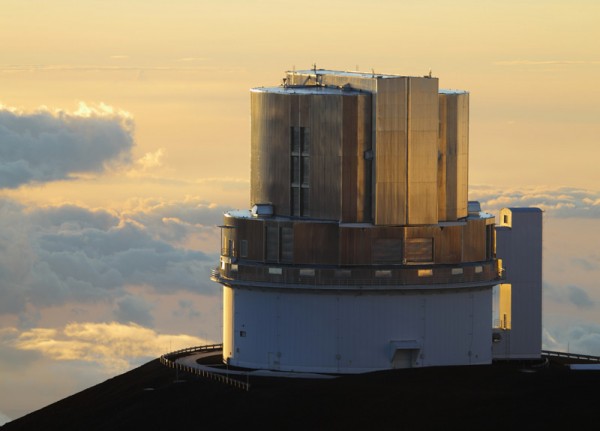.

Burst snapper.The Subaru Telescope in Hawaii captured light from the distant gamma ray burst 130606A.
Near the beginning, the universe was without form and void, and darkness was upon the face of the deep. That's because until about a billion years after the big bang, there were no galaxies or stars to illuminate the heavens, which were then filled primarily with neutral hydrogen gas. But a rare ultra–high-energy stellar explosion called a gamma ray burst (GRB) has offered a new glimpse into this obscure period—the so-called cosmic dark ages—and may help nail down precisely when it ended. A study of the explosion's afterglow suggests that such neutral hydrogen abounded a billion years after the big bang, so the dark ages weren’t quite over then, a team of Japanese astronomers reports.
The dark ages lasted until the first stars and galaxies formed from gathering clumps of gas and their light broke apart, or reionized, the hydrogen atoms. (Today, the vast majority of hydrogen in intergalactic space is ionized.) To find out when that happened, researchers want to measure how much neutral hydrogen was still around at various times in the universe’s past.
One way to do this is to detect the so-called 21-centimeter radiation, a faint radio signal emitted by neutral hydrogen. But the radio telescopes able to do this are not yet accurate enough to see that far back into the past. Astronomers can also look at the light from quasars, which are very bright galactic nuclei, to search for the absorption of telltale wavelengths of light by nearby neutral hydrogen surrounding the quasar. (Ionized hydrogen does not absorb optical radiation.) But quasar spectra can be harder to interpret because quasars reside in large galaxies and will likely have ionized much of the gas around them anyway.
A third way is to study GRBs, very rare but exceedingly powerful explosions that occur when a large, rapidly rotating star collapses and causes a supernova or hypernova. The explosion shoots a narrow beam of radiation into space which, if it is pointed toward Earth, appears as a flash of gamma rays in the sky that lasts seconds or minutes, followed by a longer lasting afterglow at longer wavelengths. As with a quasar, radiation from a GRB afterglow can be used to search for neutral hydrogen in the explosion's neighborhood. GRBs are potentially cleaner as sources of light because they originate in small galaxies or away from galaxies altogether.
Tomonori Totani, an astronomer at the University of Tokyo, and colleagues got a lucky glimpse of just such a GRB. GRB 130606A was detected last June by NASA’s Swift satellite. As is common for such an event these days, telescopes the world over swiveled to catch some of its light, including Japan’s Subaru Telescope in Hawaii. Because it was very bright, Subaru’s Faint Object Camera and Spectrograph was able to measure the spectrum of its afterglow precisely. What made this GRB special was that it was very distant, with a redshift of 5.913, which means that it exploded when the ever-expanding universe was just one-seventh its current size and only 1 billion years old.
From the GRB's spectrum, the researchers calculate that 10% of the intergalactic gas surrounding the burst consisted of neutral hydrogen, they report in a paper to be published in June in the Publications of the Astronomical Society of Japan. The abundance of neutral hydrogen suggests that the reionization process that ended the dark ages was not yet complete at that time.
“It's an interesting result, and the best constraint on the Epoch of Reionization coming from a [GRB],” writes astrophysicist Avery Meiksin of the University of Edinburgh in the United Kingdom in an e-mail. But better data has come from a quasar discovered in 2010. Its redshift of 7.1 puts it just 770 million years after the big bang. Extensive analysis of its spectrum showed nearby gas to be at least 10% neutral hydrogen, and similar analysis would be needed to draw firm conclusions from this GRB, Meiksin says. "I'd say the main significance of this result is that it's a GRB, which promises that there will be more data similar to it in the future,” he adds. Rennan Barkana, an astrophysicist at Tel Aviv University in Israel, agrees that the very high-quality spectrum provides "mild evidence" of neutral hydrogen, but there are many uncertainties. He says that evidence from GRBs is “very promising.”
“The main limitation of this kind of study is the low event rate of such bright GRBs at sufficiently high redshift,” Totani writes in an e-mail. But that situation will likely improve in the next decade as the next generation of gigantic telescopes, such as the Thirty Meter Telescope and the European Extremely Large Telescope, come online, Totani says, as they should be able to spot much fainter and, hence, more abundant GRBs.
Quelle: AAAS
